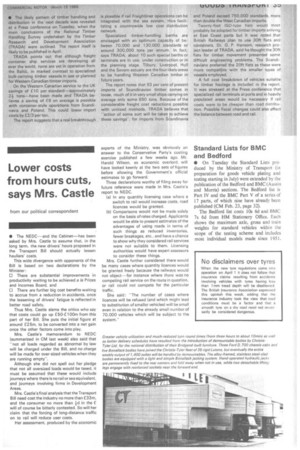Lower costs from hours cuts, says Mrs. Castle
Page 37

If you've noticed an error in this article please click here to report it so we can fix it.
from our political correspondent
• The NEDC—and the Cabinet—has been asked by Mrs. Castle to assume that, in the long term, the new drivers' hours proposed in the Transport Bill should actually lessen hauliers' costs.
This wide divergence with opponents of the Bill is based on two declarations by the Minister : • There are substantial improvements in
productivity waiting to be achieved a Is Prices and Incomes Board, and
O There are further big cost benefits waiting to accrue from a reduction in accidents, once the lessening of drivers' fatigue is reflected in better road safety.
Thus Mrs. Castle slams the critics who say that costs could go up £50-£ 100m from this part of her Bill. She puts the initial figure at around £25m, to be converted into a net gain once the other factors come into play.
Mrs. Castle's memorandum to NEDC (summarized in CM last week) also said that "not all loads regarded as abnormal by law will be charged under the Bill, and no charge will be made for over-sized vehicles when they are running empty-.
Although she did not spell out her pledge that not all oversized loads would be taxed, it must be assumed that these would include journeys where there is no rail or sea equivalent, and journeys involving firms in Development Areas.
Mrs. Castle's fi nal analysis that the Transport Bill need cost the industry no more than £33m, and the consumer no more than +d in the £ will of course be bitterly contested. So will her claim that the forcing of long-distance traffic on to rail will reduce user costs.
Her assessment, produced by the economic experts of the Ministry, was obviously an answer to the Conservative Party's costing exercise published a few weeks ago. Mr. Harold Wilson, as economic overlord, will have looked keenly at the two sets of figures before allowing the Government's official estimates to go forward.
Three declarations worthy of filing away for future reference were made in Mrs. Castle's report to NEDC.
(a) In any quantity licensing case where a switch to rail would increase costs, road licences would be granted.
lb) Comparisons would not be made solely on the basis of rates charged. Applicants would be able to present estimates of the advantages of using roads in terms of such things as reduced inventories, fewer breakages, etc., and have a chance to show why they considered rail services were not suitable to them. Licensing authorities would have expert assessors to consider these things.
Mrs. Castle further considered there would be many cases where quantity licences would be granted freely because the railways would not object—for instance where there was no competing rail service on the route in question. or rail could not compete for the particular traffic.
She said : "The number of cases where licences will be refused (and which might lead to substitution of smaller vehicles) will be small even in relation to the already small number of 70,000 vehicles which will be subject to the system."
Standard Lists for BMC and Bedford • On Tuesday the Standard Lists produced by the Ministry of Transport (in preparation for goods vehicle plating and testing starting in July) were extended by the publication of the Bedford and BMC (Austin and Morris) sections. The Bedford list is Part IV and the BMC Part V of a series of 17 parts, of which nine have already been published (CM Feb. 23, page 32).
The Bedford list costs lOs 6d and BMC 7s 6d from HM Stationery Office. Each shows the maximum axle, gross and train weights for standard vehicles within the scope of the testing scheme and includes most individual models made since 1951.




































































































































